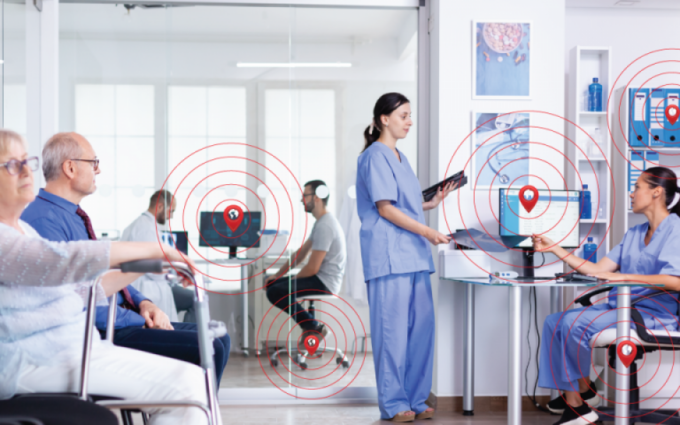Embarking on a journey through the intricate corridors of healthcare, we’re here to explore how asset tracking emerges as a silent hero, reshaping the industry dynamics.
Imagine a world where medical professionals effortlessly locate critical equipment, ensuring swift responses to patient needs. This post is your backstage pass into the realm where asset tracking isn’t just about inventory; it’s about elevating patient care.
As you continue reading this post, we will unravel the tapestry of benefits that seamlessly integrating asset tracking systems brings to healthcare facilities. From streamlined resource allocation to the seamless orchestration of patient-centric services, each aspect weaves into the narrative of a more efficient and compassionate healthcare landscape.
Yet, as with any innovation, challenges arise. We’ll candidly address the hurdles that healthcare organizations encounter when embracing asset tracking solutions.
Join us as we navigate these challenges together, unveiling practical strategies to triumph over them. So, fasten your seat belts as we embark on a journey to transform healthcare- one tracked asset at a time.
Benefits of Asset Tracking in Healthcare
Enhanced Patient Safety

Prioritizing patient safety is paramount in healthcare. Hospital asset management software tools prove to be the guardians of regular maintenance and calibration for medical equipment. This ensures optimal performance and reliability.
By vigilantly tracking equipment expiration dates, healthcare providers preemptively thwart the use of outdated or ineffective instruments on patients. It’s more than just a technology; it’s a commitment to fortifying the safety net that underlies every patient’s care journey.
Improved Efficiency
Integrating hospital management software is a game-changer for healthcare efficiency. This tech gem offers real-time data, letting staff effortlessly find equipment when needed.
No more time wasted hunting down items- now, quick responses in emergencies become second nature. This isn’t just about software; it’s about empowering healthcare professionals with the tools they need, precisely when they need them, ensuring a seamless and swift response to critical situations.
Effective Inventory Control
In the intricate world of healthcare, effective inventory control is non-negotiable. Hospital asset tracking systems emerge as indispensable allies, providing crucial insights into stock levels, reordering needs, and asset utilization rates.
This isn’t just about numbers; it’s about ensuring the right resources are available when needed. By harnessing this technology, healthcare facilities optimize their inventory, curbing unnecessary purchases and averting shortages or delays caused by supply hiccups.
It’s a smart, human-centered approach to managing resources, ensuring seamless operations, and, ultimately, enhancing the quality of patient care.
Challenges Faced by Healthcare Organizations
Cost Considerations

Navigating the realm of asset tracking in healthcare, the hurdle of cost often looms large. Initial investments in infrastructure and software might seem daunting.
Yet, the long-term gains invariably outweigh this expense, promising enhanced efficiency and patient care.
To alleviate cost concerns, organizations can adopt savvy strategies- exploring options like leasing or forging partnerships with tech vendors offering flexible pay-as-you-go arrangements. It’s a thoughtful investment in a system that pays dividends in improved operations and better healthcare outcomes.
Implementation Complexities
The integration of asset tracking systems into existing healthcare operations demands thoughtful planning and execution due to the intricate processes involved.
This encompasses ensuring compatibility with existing IT infrastructure, migrating data from legacy systems, training staff on emerging technologies, and adhering to compliance standards through proper validation procedures.
Beyond the technical aspects, this process is a human endeavor, emphasizing the importance of seamless transition and the empowerment of healthcare professionals in adopting and maximizing the benefits of these transformative technologies.
Strategies for Successful Implementation
Conduct a Pilot Program
Before taking a leap into full-scale implementation, consider kicking off with a pilot program for testing asset tracking systems on a smaller scale.
Choose a specific department or unit within the healthcare facility to access the system’s real-world performance. This step-by-step approach allows for a hands-on evaluation, highlighting any potential issues and making necessary adjustments before scaling up.
It’s like a trial run, ensuring that the technology aligns seamlessly with the daily workings of the healthcare environment. This thoughtful pilot phase sets the stage for a more effective and tailored integration when rolling out the system on a larger scale.
Involve Key Stakeholders

Incorporating doctors, nurses, administrators, and IT personnel as key stakeholders is essential during the implementation of asset tracking systems in healthcare. Collaborating with these vital contributors ensures a comprehensive understanding of their needs and facilitates a smoother adoption process.
Their valuable insights play a crucial role in ensuring the proper integration and effectiveness of asset tracking systems. To guarantee seamless alignment with existing workflows, soliciting input and feedback from end-users becomes vital.
This collaborative approach transforms the implementation journey into a tailored experience, allowing the asset tracking system to evolve organically based on real-world needs. The result is a technology solution that not only meets but anticipates the diverse requirements of healthcare professionals, enhancing overall efficiency and effectiveness.
Training the Staff
One crucial aspect is providing training to staff members to maximize the benefits of the asset tracking system. It is recommended to design training programs based on user groups’ roles and responsibilities within the organization. Ongoing support and refresher courses should also be made available to encourage adoption and prevent any usage gaps.
Additionally, exploring integration opportunities between asset tracking systems and other healthcare technologies like medical record systems can greatly enhance efficiency. This integration allows for data flow, reduces input efforts by staff members, and improves overall efficiency.
Conclusion

Incorporating asset tracking systems into healthcare facilities has the potential to enhance patient care and operational efficiency. By utilizing real-time data on equipment location, it becomes more manageable to address compliance risks associated with instruments.
Although there are challenges in implementing these systems (such as cost considerations and complex integration processes), healthcare organizations can overcome them through planning, piloting, engaging stakeholders, implementing training programs, and exploring integration opportunities with existing technology tools used in clinical settings.
It’s important to keep in mind that embracing technologies is an effort that requires constant communication among everyone involved in healthcare, from administrators to care providers. By working and valuing the perspectives of each stakeholder, we can improve patient outcomes by effectively monitoring assets across healthcare networks.









